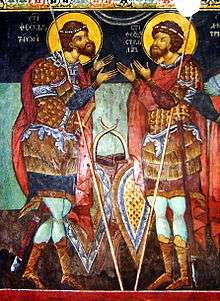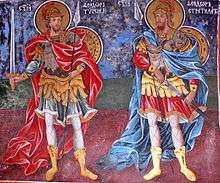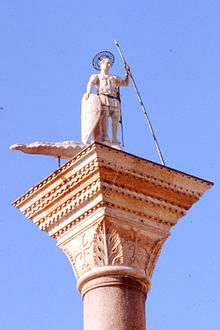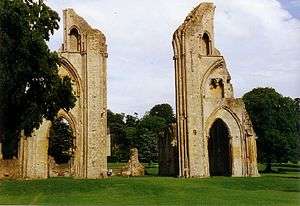Theodore the Martyr
| Theodore the Martyr | |
|---|---|
 Saints Theodore of Amasea and Theodore Stratelates in a fresco from Kremikocvtsi Monastery, near Sofia, Bulgaria | |
| Born | Θεόδωρος |
| Known for | Sainthood |
| Religion | Christian |
Theodore the Martyr was the name of a number of Christian saints. Two of the best known, Theodore of Amasea and Theodore Stratelates, were probably the same person. A variety of stories are told about Theodore the Martyr. Relics of Theodore the Martyr, including at least four bodies as well as body parts, were taken to Venice, where he is one of the patron saints, or to other places in Western Europe.
Identification
Theodore is a Greek name, Θεόδωρος (Theodōros), meaning "God's gift" (from the Greek words Θεός, (theos) "God" and δώρον (dōron) "gift").[1] A number of Christian Saints named Theodore were martyred. Perhaps the earliest recorded is Theodore, of Theodore and Pausilippus, martyrs who died around 130 AB in Byzantium, and who have a feast day on 9 April.[2]
The best known saint called Theodore the Martyr is probably Theodore of Amasea, also called Theodore Tyro.[3] The suffix Tiro means "recruit".[4] Stories include a miracle where Theodore Tyro rescued a child who had been sold to the Ishmaelites as a slave, and an occasion when he rescued his mother from the jaws of a dragon.[5] He refused to take part in a pagan ceremony, and then set fire to the temple of Cybele, near Amasya in Pontus. He was burned to death in a furnace as punishment.[4] His sanctuary was established at Euchaita.[3]
Theodore of Amasea was almost certainly the same person as Theodore Stratelates. Theodore Stratelates, also called Theodore of Heraclea, was a Roman general in the army of the Emperor Licinius (r. 308–324). He was either beheaded or crucified at the command of the emperor. Theodore Stratelates is an important saint in the Greek Orthodox Church.[4]
Accounts

According to the Book of the Saints of the Ethiopian Church, Saint Theodore the Martyr was a captain of the soldiers of the city of Setb, in the province of Asyut in Upper Egypt. A church was dedicated to him, and great signs and wonders took place through his body.[6] Abu al-Makarim, writing in 1348, says there was a church named after him in Babylon, Egypt.[7]
Gregory of Nyssa (c. 335 – c. 395) gave an Oration on Theodore the Martyr in Amasya in 383, in the church where the saint's remains were said to be located.[8] This Theodore was a Roman soldier martyred around 303 in the time of the Emperor Maximian (c. 250 – 310).[9] He was among a surge of soldiers who were martyred in the 4th century.[8] He is described as "a poor soldier, newly conscripted."[10] Gregory said, "This, as we believe, is he who during the past year calmed the stormy fury of the barbarians, and stopped the terrible war of the savage Scythians".[11] He called on Theodore for assistance, saying "gather together the troops of thy brother martyrs, and thou with them beseech God to stay the invasion of the barbarians."[12] Gregory wrote, "The hues of the ornamentation in the church are veritably like a book that speaks, for painting even if silent knows how to speak from the wall."[13] This speech is often used in defense of the use of religious images.[9]
The Emperor John I Tzimiskes fought a successful battle against the Russians in 970 in which the whole Greek army saw a champion on a white force fighting before the first ranks. He disappeared after the battle was won.[14] The Russian prince Sviatoslav I of Kiev was forced to abandon Bulgaria and retreat to Russia.[15] The victory occurred on the anniversary of Saint Theodore the Martyr, and the army thought that the knight on the white horse was the saint.[14] The emperor repaired the church of Theodore in Euchaneia, and changed the name of that city to Theodoropolis.[14][lower-alpha 1]
Saint Theodore was the patron saint of the Capuchins.[17] An observer in Rome in 1844 of a Capuchin's panegyric of Saint Theodore at the church dedicated to the martyr, on the saint's day, recorded as a sample,
But he hath left us the memory of his battles as a lesson, assembling the faithful in crowds, instructing the Church, driving away evil spirits, bringing down good angels among us, procuring all suitable gifts for us from God, converting this place into a hospital for every variety of disease, a haven for those who are tossed in a sea of affliction, a store-house for the needy poor, a secure home for the wayfarer, a never-failing place of meeting for those who celebrate the festival.[17]
Relics
Italy

In 1100 the remains of Saint Theodore the Martyr were stolen from Myra in Asia Minor and taken to Venice, along with the body of Saint Nicholas of Myra and his uncle, also Nicholas.[18] This occurred during an expedition to the Holy Land of about 200 ships dispatched by the Doge Vitale Michiel of Venice under the spiritual leadership of Enrico Contarini, the Bishop of Olivolo.[19] Theodore the Martyr became one of the four tutelary guardians of Venice, along with the angel Gabriel, the Virgin Mary and Saint Mark the Evangelist.[20]
In 1257 Jacopo Dauro raided Mesembria on the Bulgarian coast of the Black Sea, and took the headless body of Saint Theodore the Martyr from its church of Saint Sophia. The saint was headless because the Emperor Licinius had decapitated him after he had slain a dragon. A relative of Jacopo, Marco Dauro, took the body to Venice where he placed it in the church of San Salvador. Saint Theodore and the dragon were later commemorated in a statue on top of his column in Venice.[21] The Irish friar Simon Fitz-Simon passed through Venice in 1323 on his way to the Holy Land, and listed Theodore the Martyr among the bodies of saints that lay in the city, "whole and uncorrupted".[22]
The Jesuit Richa in his History of the Churches of Florence recorded that at the Convent of our Lady of the Murate there was a rib of St. Theodore the Martyr, which had been mislaid and forgotten, but which the saint revealed in a vision to Sister Maria of Scarperia. The chronicle of the convent included many wonderful events associated with this relic.[23] An 1872 account tells of a small church of Theodore the Martyr at the foot of Palatine Hill in Rome. Mothers would bring their children to the church to kiss the saint's relic.[24]
Elsewhere

At Thorney, Cambridgeshire, England, a new church was built by Abbott Gunther in 1069. In 1105 relics of Theodore the Martyr were translated to the church.[25] John of Glastonbury's Cronica sive Antiquitates Glastoniensis Ecclesie, written in the mid-14th century, recorded that Glastonbury Abbey had relics of Theodore the Martyr.[26]
During the Fourth Crusade (1202–1204) the German monk Gunther of Pairis obtained a variety of relics, including a trace of the blood of Jesus.[27] The collection included a piece of the True Cross, a piece of Saint John the Baptist and the arm of Saint James the Great. There were relics of other saints including Theodore the Martyr.[28]
The Clairvaux inventory of 1504 included a number of relics including the shoulder blade of Saint Theodore the Martyr.[29] The Dames de l'Assomption of rue Saint-Honoré in Paris, who rebuilt their church in 1670 at their own expense, preserved the body of Saint Theodore the Martyr with great veneration. It had been given to them by Cardinal Antonio Barberini, the Archbishop of Rheims.[30]
Philip II of Spain (1527–1598) was a great collector of relics, and accumulated a huge collection. It included 290 teeth of Saint Apollonia, the patron saint of toothache.[31] His successors continued to add to the collection.[32] In 1762 it was reported that the body of Saint Theodore the Martyr was lying in a magnificent shrine of silver or brass gilt, adorned with crystals and gems and enameled with gold, in the monastery of El Escorial near Madrid, Spain.[33]
Notes
- ↑ Katsev 2013.
- ↑ Walsh 2007, p. 579ff.
- 1 2 Walter 2003, p. 46.
- 1 2 3 Bunson & Bunson 2003, p. 789.
- ↑ Walter 2003, p. 48.
- ↑ Book of the Saints of the Ethiopian Church, p. 210.
- ↑ Armenian 2001, p. 328.
- 1 2 Bitton-Ashkelony 2005, p. 35.
- 1 2 Borromeo 2010, p. 235.
- ↑ Greer 2008, p. 110.
- ↑ Smith & Wace 1887.
- ↑ Freeman 1839, p. 306.
- ↑ Biale 2012, p. 200.
- 1 2 3 Universal History 1780, p. 98.
- ↑ Kelly 1854, p. 25.
- ↑ Walter 2003, p. 58.
- 1 2 Mant 1844, p. 77.
- ↑ Nicol 1992, p. 25.
- ↑ Nicol 1992, p. 71.
- ↑ Batty 1820, p. 169.
- ↑ Nicol 1992, p. 186.
- ↑ Davis & Marvin 2004, p. 18.
- ↑ Trollope 1856, p. 363-4.
- ↑ A.W. 1872, p. 102.
- ↑ Crick & Houts 2011, p. 309.
- ↑ Carley 1985, p. 27.
- ↑ Bird, Peters & Powell 2013, p. 61.
- ↑ Bird, Peters & Powell 2013, p. 62.
- ↑ Schenk 2012, p. 204.
- ↑ The History of Paris 1825, p. 314.
- ↑ Fuentes 1999, p. 164.
- ↑ Noone 1998, p. 30.
- ↑ Thompson 1762, p. 227.
Sources
- Armenian, Abu Salih the (2001). The Churches and Monasteries of Egypt and Some Neighbouring Countries. Gorgias Press LLC. ISBN 978-0-9715986-7-6.
- A.W. (1872). "Our Ancestors". The Month: An Illustrated Magazine of Literature, Science and Art. The Month. Retrieved 2013-11-27.
- Batty, Elizabeth Frances (1820). Italian Scenery: From Drawings Made in 1817. Rodwell & Martin. Retrieved 2013-11-27.
- Biale, David (2012-08-29). Cultures of the Jews: A New History. Knopf Doubleday Publishing Group. ISBN 978-0-307-48346-1. Retrieved 2013-11-27.
- Bird, Jessalynn; Peters, Edward; Powell, James M. (2013-03-26). Crusade and Christendom: Annotated Documents in Translation from Innocent III to the Fall of Acre, 1187–1291. University of Pennsylvania Press. ISBN 978-0-8122-0765-1. Retrieved 2013-11-26.
- Bitton-Ashkelony, Bruria (2005). Encountering the Sacred: The Debate on Christian Pilgrimage in Late Antiquity. University of California Press. ISBN 978-0-520-93112-1. Retrieved 2013-11-27.
- Borromeo, Federico (2010). EST Des Beigef. Werkes: Musaeum. Harvard University Press. ISBN 978-0-674-04758-7. Retrieved 2013-11-27.
- Book of the Saints of the Ethiopian Church: A Translation of the Ethiopic Synaxarium (Mashafa Senkesar) : Made from the Mss. Oriental 660 and 661 in the British Museum. CUP Archive. 1928. GGKEY:CWSRNA6K1R2. Retrieved 2013-11-26.
- Bunson, Matthew; Bunson, Stephen (2003). Our Sunday Visitor's Encyclopedia of Saints. Our Sunday Visitor Publishing. ISBN 978-1-931709-75-0. Retrieved 2013-11-27.
- Carley, James P. (1985). The Chronicle of Glastonbury Abbey: An Edition, Translation and Study of John of Glastonbury's "Cronica Sive Antiquitates Glastoniensis Ecclesie". Boydell & Brewer. ISBN 978-0-85115-859-4.
- Crick, Julia C.; Houts, Elisabeth van (2011-04-21). A Social History of England, 900–1200. Cambridge University Press. ISBN 978-1-139-50085-2. Retrieved 2013-11-27.
- Davis, Robert Charles; Marvin, Garry (2004). Venice, the Tourist Maze: A Cultural Critique of the World's Most Touristed City. University of California Press. ISBN 978-0-520-24120-6. Retrieved 2013-11-27.
- Freeman, Samuel (1839). "A Discourse Concerning the Invocation of Saints". The Protestant's manual: consisting of sermons and tracts, selected from the works of the best English divines, on the principal points of the popish controversy : with an introduction and notes. William Whyte and Co., Glasgow, W. Collins. Retrieved 2013-11-26.
- Fuentes, Carlos (January 1999). The Buried Mirror: Reflections on Spain and the New World. Houghton Mifflin Harcourt. ISBN 978-0-395-92499-0. Retrieved 2013-11-27.
- Greer, Rowan A. (2008-01-31). The Fear of Freedom. Penn State Press. ISBN 978-0-271-03944-2. Retrieved 2013-11-27.
- Katsev, Igor (2013). "Origin and Meaning of Theodore". Mfnames.com. Retrieved 2013-11-27.
- Kelly, Walter Keating (1854). The history of Russia, from the earliest period to the present time: Compiled from the most authentic sources, including the Works of Karamsin, Tooke, and Ségur. In 2 vol. Bohn. Retrieved 2013-11-27.
- Mant, Richard (1844). "Rome, her tenets and her Practices". The Dublin Review. Burns and Oates. Retrieved 2013-11-26.
- Nicol, Donald M. (1992-05-07). Byzantium and Venice: A Study in Diplomatic and Cultural Relations. Cambridge University Press. ISBN 978-0-521-42894-1. Retrieved 2013-11-26.
- Noone, Michael John (1998). Music and Musicians in the Escorial Liturgy Under the Habsburgs, 1563–1700. University Rochester Press. ISBN 978-1-878822-71-0. Retrieved 2013-11-27.
- Schenk, Jochen (2012-03-29). Templar Families: Landowning Families and the Order of the Temple in France, C.1120–1307. Cambridge University Press. ISBN 978-1-107-00447-4. Retrieved 2013-11-26.
- Smith, William; Wace, Henry (1887). A Dictionary of Christian Biography, Literature, Sects and Doctrines: Being a Continuation of 'The Dictionary of the Bible'. Little, Brown & Company.
- The History of Paris: From the Earliest Period to the Present Day; Containing a Description of Its Antiquities, Public Buildings, Civil, Religious, Scientific and Commercial Institutions ... To which is Added, an Appendix: Containing a Notice of the Church of Saint Denis; an Account of the Violation of the Royal Tombs; Important Statistical Tables. A. and W. Galignani. 1825.
- Thompson, George (1762). "A description of the Escurial". The critical review, or annals of literature. Retrieved 2013-11-26.
- Trollope, Thomas Adolphus (1856). The girlhood of Catherine de' Medici. Chapman and Hall. Retrieved 2013-11-26.
- Universal History (1780). An universal history, from the earliest accounts to the present time. Retrieved 2013-11-26.
- Walsh, Michael J. (2007). A New Dictionary of Saints: East and West. Liturgical Press. ISBN 978-0-8146-3186-7. Retrieved 2013-11-27.
- Walter, Christopher (2003). The Warrior Saints in Byzantine Art and Tradition. Ashgate Publishing, Ltd. ISBN 978-1-84014-694-3. Retrieved 2013-11-26.